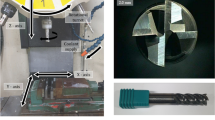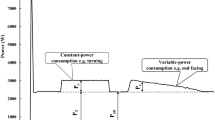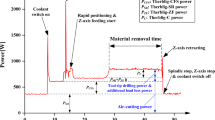Abstract
Analyzing and modeling the power and energy consumption of machining processes have been considered to be an important approach to enhance the energy performance of manufacturing process. As drilling process is one of the most commonly used technologies in manufacturing, specialized research on the modeling method of material drilling power of drilling is very rare. The predictive accuracies of existing models for feeding power and material drilling power have great potential for improving. To fill this gap, improved predictive models of feeding power and material drilling power of drilling process are proposed in this research. To show the feasibility of the proposed modeling methods of feeding power and material drilling power, extensive experimental studies were carried out on a machining center. The research results show that the predictive accuracies are generally improved by 1–2% with the established feeding power model in this article compared with the existing model. Moreover, the predictive accuracies of all the tested drilling cases by using the established material drilling power model are above 90.0%, and a high average accuracy of 95.0% is achieved. The established power models of drilling process in this research build a good basis for modeling of total drilling power and energy optimization.
Similar content being viewed by others
References
Akbostancı E, Tunç Gİ, Türüt-Aşık S (2011) CO2 emissions of Turkish manufacturing industry: a decomposition analysis. Appl Energy 88(6):2273–2278
International Energy Agency (IEA) (2012) World energy outlook http://www.worldenergyoutlook.org/publications/weo-2012
International Energy Agency (IEA) (2007) Tracking industrial energy efficiency and CO2 emission. OECD/IEA, Paris
Seow Y, Goffin N, Rahimifard S, Woolley E (2016) A ‘design for energy minimization’ approach to reduce energy consumption during the manufacturing phase. Energy 109:894–905
Hu L, Peng T, Peng C, Tang R (2017) Energy consumption monitoring for the order fulfilment in a ubiquitous manufacturing environment. Int J Adv Manuf Technol 89(9–12):3087–3100
Peng T, Xu X (2014) Energy-efficient machining systems: a critical review. Int J Adv Manuf Technol 72(9–12):1389–1406
Zhou L, Li J, Li F, Xu X, Wang L, Wang G, King L (2017) An improved cutting power model of machine tools in milling process. Int J Adv Manuf Technol 27(91):2383–2340
Altıntaş RS, Kahya M, Ünver HÖ (2016) Modelling and optimization of energy consumption for feature based milling. Int J Adv Manuf Technol 86(9–12):3345–3363
Campatelli G, Scippa A, Lorenzini L, Sato R (2015) Optimal workpiece orientation to reduce the energy consumption of a milling process. Int J Precis Eng Man-GT 2(1):5–13
Tristo G, Bissacco G, Lebar A, Valentinčič J (2015) Real time power consumption monitoring for energy efficiency analysis in micro EDM milling. Int J Adv Manuf Technol 78(9–12):1511–1521
Ma F, Zhang H, Cao H, Hon KKB (2017) An energy consumption optimization strategy for CNC milling. Int J Adv Manuf Technol 90(5–8):1715–1726
Li C, Chen X, Tang Y, Li L (2017) Selection of optimum parameters in multi-pass face milling for maximum energy efficiency and minimum production cost. J Clean Prod 140:1805–1818
Albertelli P, Keshari A, Matta A (2016) Energy oriented multi cutting parameter optimization in face milling. J Clean Prod 137:1602–1618
Jia S, Tang R, Lv J, Zhang Z, Yuan Q (2016) Energy modeling for variable material removal rate machining process: an end face turning case. Int J Adv Manuf Technol 85(9):2805–2818
Rajemi MF, Mativenga PT, Aramcharoen A (2010) Sustainable machining: selection of optimum turning conditions based on minimum energy considerations. J Clean Prod 18(10–11):1059–1065
Zhong Q, Tang R, Lv J, Jia S, Jin M (2016) Evaluation on models of calculating energy consumption in metal cutting processes: a case of external turning process. Int J Adv Manuf Technol 82(9):2087–2099
Jia S, Tang R, Lv J, Yuan Q, Peng T (2017) Energy consumption modeling of machining transient states based on finite state machine. Int J Adv Manuf Technol 88(5):2305–2320
Li W, Winter M, Kara S, Herrmann C (2012) Eco-efficiency of manufacturing processes: a grinding case. CIRP Ann Manuf Technol 61(1):59–62
Murray VR, Zhao F, Sutherland JW (2012) Life cycle analysis of grinding: a case study of non-cylindrical computer numerical control grinding via a unit-process life cycle inventory approach. Proc Inst Mech Eng B J Eng Manuf 226(10):1604–1611
Amran MA, Salmah S, Hussein NIS, Izamshah R, Hadzley M, Sivaraos KMS, Sulaiman MA (2013) Effects of machine parameters on surface roughness using response surface method in drilling process. Procedia Eng 68:24–29
Jia S (2014) Research on energy demand modeling and intelligent computing of machining process for low carbon manufacturing. Zhejiang University, Hangzhou
Fysikopoulos A, Pastras G, Alexopoulos T, Chryssolouris G (2014) On a generalized approach to manufacturing energy efficiency. Int J Adv Manuf Technol 73(9–12):1437–1452
Paryanto BM, Bornschlegl M, Franke J (2015) Reducing the energy consumption of industrial robots in manufacturing systems. Int J Adv Manuf Technol 78(5–8):1315–1328
Chua KJ, Chou SK (2011) A performance-based method for energy efficiency improvement of buildings. Energy Convers Manage 52(4):1829–1839
Liu Z, Xu W, Zhai X, Qian C, Chen X (2017) Feasibility and performance study of the hybrid ground-source heat pump system for one office building in Chinese heating dominated areas. Renew Energy 101:1131–1140
Yang F, Liu Y, Liu G (2016) A process simulation based benchmarking approach for evaluating energy consumption of a chemical process system. J Clean Prod 112:2730–2743
Cagno E, Trucco P, Trianni A, Sala G (2010) Quick-E-Scan: a methodology for the energy scan of SMEs. Energy 35(5):1916–1926
Schudeleit T, Züst S, Weiss L, Wegener K (2016) The total energy efficiency index for machine tools. Energy 102:682–693
Lv J, Tang R, Jia S, Liu Y (2016) Experimental study on energy consumption of computer numerical control machine tools. J Clean Prod 112:3864–3874
Cai W, Liu F, Xie J Liu P, Tuo J (2017) A tool for assessing the energy demand and efficiency of machining systems: energy benchmarking. Energy 138:332–347
Jia S, Yuan Q, Ren D, Lv J (2017) Energy demand modeling methodology of key state transitions of turning processes. Energies 10(4):462 1–19
Hu L, Tang R, Liu Y, Cao Y, Tiwari A (2018) Optimising the machining time, deviation and energy consumption through a multi-objective feature sequencing approach. Energy Convers Manage 160:126–140
Cai W, Liu C, Zhang C, Ma M, Rao W, Li W, He K, Gao M (2018) Developing the ecological compensation criterion of industrial solid waste based on energy for sustainable development. Energy 157:940–948
Liu P, Liu F, Qiu H (2017) A novel approach for acquiring the real-time energy efficiency of machine tools. Energy 121:524–532
Cai W, Liu F, Zhou X (2017) An energy management approach for the mechanical manufacturing industry through developing a multi-objective energy benchmark. Energy Convers Manage 132:361–371
Jia S, Yuan Q, Lv J, Liu Y, Ren D, Zhang Z (2017) Therblig-embedded value stream mapping method for lean energy machining. Energy 138:1081–1098
Aramcharoen A, Mativenga PT (2014) Critical factors in energy demand modelling for CNC milling and impact of toolpath strategy. J Clean Prod 78:63–74
Chen X, Li C, Jin Y, Li L (2018) Optimization of cutting parameters with a sustainable consideration of electrical energy and embodied energy of materials. Int J Adv Manuf Technol 96(1–4):775–788
Li W, Kara S (2011) An empirical model for predicting energy consumption of manufacturing processes: a case of turning process. Proc Inst Mech Eng B J Eng Manuf 225(9):1636–1646
Jia S, Yuan Q, Cai W, Li M, Li Z (2018) Energy modeling method of machine-operator system for sustainable machining. Energy Convers Manage 172:265–276
Winter M, Li W, Kara S, Herrmann C (2014) Determining optimal process parameters to increase the eco-efficiency of grinding processes. J Clean Prod 66:644–654
Filleti RAP, Silva DAL, da Silva EJ, Ometto AR (2017) Productive and environmental performance indicators analysis by a combined LCA hybrid model and real-time manufacturing process monitoring: a grinding unit process application. J Clean Prod 161:510–523
Zheng J, Huang B, Zhou X (2018) A low carbon process design method of sand casting based on process design parameters. J Clean Prod 197:1408–1422
Yoon HS, Moon JS, Pham MQ, Lee GB, Ahn SH (2013) Control of machining parameters for energy and cost savings in micro-scale drilling of PCBs. J Clean Prod 54:41–48
Franco A, Rashed CAA, Romoli L (2016) Analysis of energy consumption in micro-drilling processes. J Clean Prod 137:1260–1269
Yoon HS, Bhandari B, Moon JS, Kim CS, Lee GB, Park KW, Song CK, Ahn SH (2012) Energy analysis of micro-drilling process used to manufacture printed circuit boards. In: Proceedings of 19th CIRP International Conference on Life Cycle Engineering, Berkeley. pp. 305–309
Gutowski T, Dahmus J, Thiriez A (2006) Electrical energy requirements for manufacturing processes. In: Proceedings of 13th CIRP International Conference on Life Cycle Engineering, Leuven. pp. 623–628
Ai X, Xiao S (1994) Manual of cutting parameters, 3rd edn. China Machine Press, Beijing
Wang X (2008) Manual of machining process (offprint): drilling, expanding, and reaming. China Machine Press, Beijing
Lv J (2014) Research on energy supply modeling of computer numerical control machine tools for low carbon manufacturing. Zhejiang University, Hangzhou
Jia S, Tang R, Lv J (2013) Therblig-based modeling methodology for cutting power and its application in external turning. Comput Integ Manuf Syst 19(5):1015–1024
Lv J, Tang R, Jia S (2014) Therblig-based energy supply modeling of computer numerical control machine tools. J Clean Prod 65:168–177
Jia S, Tang R, Lv J (2014) Therblig-based energy demand modeling methodology of machining process to support intelligent manufacturing. J Intell Manuf 25(5):913–931
Tuo J, Liu F, Liu P, Zhang H, Cai W (2018) Energy efficiency evaluation for machining systems through virtual part. Energy 159:172–183
Acknowledgements
The authors gratefully thank all the editors and reviewers for their valuable suggestions on the improvement of this paper.
Funding
This research is supported by the National Natural Science Foundation of China (Grant No. 71701113), the Project of Shandong Province Higher Educational Science and Technology Program (Grant No. J17KA167), the Shandong Provincial Natural Science Foundation, China (Grant No. ZR2016GQ11), and by the SDUST Research Fund (Grant No. 2018YQJH103).
Author information
Authors and Affiliations
Corresponding authors
Rights and permissions
About this article
Cite this article
Jia, S., Yuan, Q., Cai, W. et al. Establishing prediction models for feeding power and material drilling power to support sustainable machining. Int J Adv Manuf Technol 100, 2243–2253 (2019). https://doi.org/10.1007/s00170-018-2861-5
Received:
Accepted:
Published:
Issue Date:
DOI: https://doi.org/10.1007/s00170-018-2861-5




